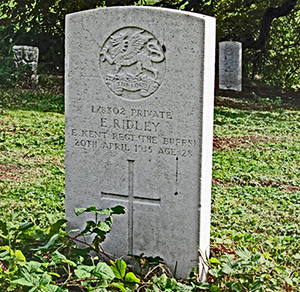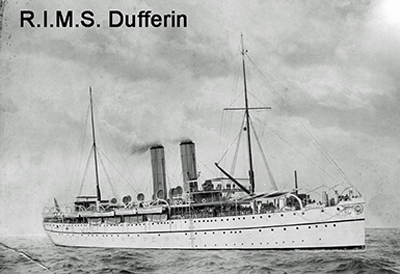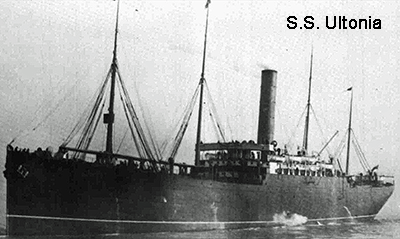First World War Project
Ernest RIDLEY (of Teynham)
b. Q3, 1887 Private, Service Number L/8302 |

Ernest Ridley was one of seven children born to George and Eleanor (sometimes "Ellen") of Lenham and Hollingbourne. In 1881, Ernest's father was a Domestic Coachman living in Maidstone Road, Lenham. After he married Eleanor (née Clark), George and his family moved to Greenstreet where he worked as a grocer's assistant. We don't know which of the several Greenstreet grocery shops he worked in. Ernest was born in the third quarter of 1887 and spent much of his early life in Greenstreet.
In his military documents, Ernest names all the members of his family as next of kin - "home" at this time is given as Champion's Cottages, Greenstreet, on the Lynsted Parish side of London Road. The family first lived in a cottage on the Teynham (north) side of Greenstreet. In the 1901 Census, Ernest's parents moved the family to a cottage close to Matilda Cottage and near Champions Cottages on the Lynsted Parish side of Greenstreet. We have placed Matilda Cottage today as being one of the cottages around 132-136 London Road. So, he was very clearly a "Greenstreet" man during his early years.
 It appears that Ernest was determined to leave behind his job as a "baker" to serve his country just as soon as he could. He first enlisted (Service Number 7976, 5th February 1906 - declared age of 18 years and 7 months) with the 3rd Battalion, The Buffs, which was the Reserve Battalion stationed at Canterbury. As soon as he approached 19 years old, on 18th June 1906, Ernest re-enlisted from the 3rd Battalion, into the 2nd Battalion, the Buffs, at Chatham (Service Number 8302). His age at this time meant he could look forward to serving overseas. His re-enlistment was initially for three years ("Short Attestation") but he then further extended his service through 1911 and onwards to 1915.
It appears that Ernest was determined to leave behind his job as a "baker" to serve his country just as soon as he could. He first enlisted (Service Number 7976, 5th February 1906 - declared age of 18 years and 7 months) with the 3rd Battalion, The Buffs, which was the Reserve Battalion stationed at Canterbury. As soon as he approached 19 years old, on 18th June 1906, Ernest re-enlisted from the 3rd Battalion, into the 2nd Battalion, the Buffs, at Chatham (Service Number 8302). His age at this time meant he could look forward to serving overseas. His re-enlistment was initially for three years ("Short Attestation") but he then further extended his service through 1911 and onwards to 1915.
 Now that he was 19 years old and able to serve overseas, Ernest travelled on the Royal Indian Mail Steamer (RIMS) "Dufferin" to serve in Hong Kong between 16th September 1908 and 4th December 1910. His next journey began when he boarded the RIMS Hardinge again, to serve a further two years in Singapore between 5th December 1910 and 31st January 1913. He then embarked the RIMS Northbrook to serve in India [Madras] between 1st February 1913 and 15th November 1914. The Battalion was then sent home aboard the S.S. Ultonia. He remained posted at Home from 16th November 1914 until 3rd April 1915 when he was medically discharged - "in consequence of being no longer physically fit for further War Service."
Now that he was 19 years old and able to serve overseas, Ernest travelled on the Royal Indian Mail Steamer (RIMS) "Dufferin" to serve in Hong Kong between 16th September 1908 and 4th December 1910. His next journey began when he boarded the RIMS Hardinge again, to serve a further two years in Singapore between 5th December 1910 and 31st January 1913. He then embarked the RIMS Northbrook to serve in India [Madras] between 1st February 1913 and 15th November 1914. The Battalion was then sent home aboard the S.S. Ultonia. He remained posted at Home from 16th November 1914 until 3rd April 1915 when he was medically discharged - "in consequence of being no longer physically fit for further War Service."
The 2nd Battalion, The Buffs, was replaced in India by the "Kent Territorial Brigade", made up of the 4th and 5th Battalions, The Buffs, and the 4th and 5th Royal West Kent Regiment who arrived in Bombay in late November 1914.
While Ernest was travelling with the Buffs, Ernest's parents moved to live in Barrow Green, Teynham (1911 Census). By the time that their son died in 1915, the family home changed again, this time to No.1, Station Road, Teynham, adjacent to London Road/Greenstreet. It was natural that Ernest's family would give their son his final resting place in St. Mary's Churchyard where he was buried on 26th April 1915.
Sadly, Ernest died only a few days after his eldest sister, Elizabeth, married George Levett Sattin, in Lynsted Church, on 4th April 1915. It is unlikely he would have been permitted (or able) to leave isolation and treatment for tuberculosis to attend this important family event. His condition on admittance to Fort Pitt Hospital was very serious.
In his records, Ernest lists as his next of kin: father George (b. 1853) and mother Ellen (b. 23rd May 1858, living in Champion's Cottages, "Teynham" [actually, Lynsted Parish]; Elizabeth (b. 1877, his oldest sister living in Sittingbourne); Thomas (b.1883); George (b.1885); Sidney (b.1891, with parents); Carrie (b.1896, sister with parents); and E. Mary (sister with parents).
His younger sister Pollie (b.1880) is not listed. Probably because by the time Ernest re-enlisted, Pollie had already married George William Epps in Lynsted Church, on 8th December 1900.
Only three weeks before his death, his sister, Elizabeth, married George Lovett Sattin (who also lost a brother, John Lovett Sattin, on 13th April 1917). Gradually, these interconnections begin to build a tragic story for the local families who were losing members of their extended families.
His death was recorded in the Faversham and North East Kent News of 12th June 1915: "Private Ernest Ridley, of the 2nd Battalion, The Buffs, who died in hospital at Chatham, was the third son of Mr. and Mrs. George Ridley, of Station Road, and was 28 years of age. He came home with his Battalion from India in December and contracted illness while under canvas at Winchester. After being for a time in Netley Hospital he was at home for some weeks and was later removed to Fort Pitt Hospital, Chatham, where he died. It was a great disappointment to him that he was unable to go to the front and take his part in the fighting. He had served nearly nine years in the Army. Deceased was buried at Teynham with military honours."
The East Kent Gazette of 19th June carried a short notice: "Private Ernest Ridley was the third son of Mr. and Mrs George Ridley of Station road, Teynham, and 28 years of age. He came home with his Battalion from India in December and contracted illness while under canvas at Winchester. After being for a time in Netley Hospital he was at home for some weeks, and was later removed to Fort Pitt Hospital, Chatham, where he died. It was a great disappointment to him that he was unable to go to the front and take his part in the fighting. He had served nearly nine years in the Army. Deceased was buried at Teynham with military honours."
Circumstances of the Death of Private Ernest Ridley
The records describe Ernest at 18 years and 11 months old. He was 5 feet 6½ inches tall, weighing 116lbs [52.6kg] after six months "service and gymnastic course". Green eyes and brown hair and a "V" shaped scar on the bridge of his nose.
His discharge documents (3rd April 1915) show Ernest as 27 years and 9 months. Chest measurement of 34½ inches with a range of expansion of 3 inches. His trade is shown as "baker". He was judged as having a "very good" military character. Under King's Regulations, he was described as "Thoroughly reliable sober and trustworthy. Has been employed as an orderly in the Orderly Room." He achieved 2nd Class certificate of education. His final service assessment was that he served for 8 years and 290 days.
His Statement of Services is puzzling as he gains and loses the rank of Lance-Corporal more than once. Attested on 18th June 1906 and posted (14th October) with the 1st Battalion as a private, he was appointed Lance-Corporal on 3rd December 1906. Confirmed paid Lance Corporal on 15th October 1907, and yet only three months later he was reverted to Private (16th January 1908). Later he was posted as a private with the 2nd Battalion (16th September 1908) and was appointed Lance Corporal again on 12th March 1909 but was reverted to private again on 31st May 1910. There follows a gap until he is shown as posted to the Depot on 25th January 1915 and "discharged being no longer fit for further War Service" on 3rd April 1915. After a further 48 days, on 20th April he died from "severe" tuberculosis in both lungs.
His medical report states that Ernest contracted tuberculosis while on leave at Teynham, Sittingbourne. On returning to England, he was first admitted to Winchester Hospital on 11th January 1915 with supposed malaria "as he had come home from India". He was then sent to Netley Hospital (or "Royal Victoria Hospital" which was the largest hospital in the world in 1915) and was sent home on sick leave on 29th January 1915 for five weeks - during which time he developed a cough. He was sent to Fort Pitt (Chatham) on 4th March when "tubercul bacilli were found in sputum". He was running a temperature of 99-100.5 degrees Fahrenheit [37.2-38 Celsius] and a pulse of 110. The Medical Report was signed off as "not the result of military service".
This judgement may have been a bit harsh as tuberculosis is not so easily caught as, generally, it relies on frequent, enclosed and crowded exposure to catch it. The incubation period for tuberculosis to show up in skin tests is 2 - 12 weeks with the emergence of full tuberculosis most likely in the following two years. So, it is arguable whether he had contracted the disease at home or overseas in barracks or in transhipment - he was clearly unwell on return from overseas (diagnosed as malaria), which may itself have triggered the full onset of tuberculosis by depressing his ability to fight the latent infection? It is worth noting that the newspaper report (transcribed above) attributes his illness to time spent under canvas at Winchester.
Although a serving soldier, his illness meant he did not qualify for any Campaign medals as he had not served in Europe. His Battalion was serving in France (B.E.F.) from 7th January 1915.
On discharge, Ernest signed a declaration (written by some other hand than his own, which only appears in the signature and an "X", suggesting illiteracy.) "I hereby understand that all monies due will be forwarded to me, as soon as my accounts have been finally adjusted by the Regimental Paymaster. I have received neither pay nor allowances since 23rd December 1914. [in his own hand he added] "only (2£) two pounds." Signed E. Ridley Private.

 World War 1 Pages
World War 1 Pages